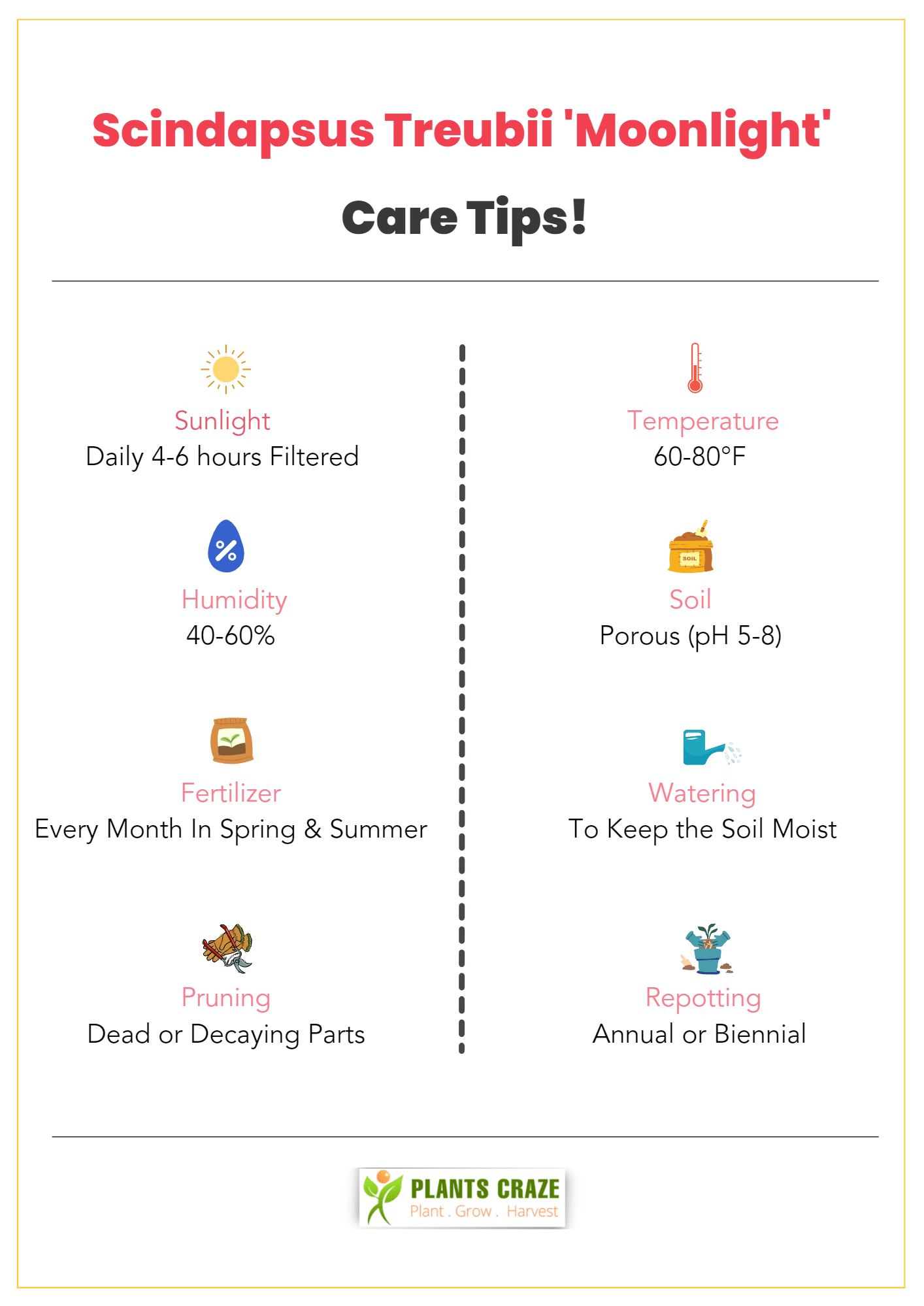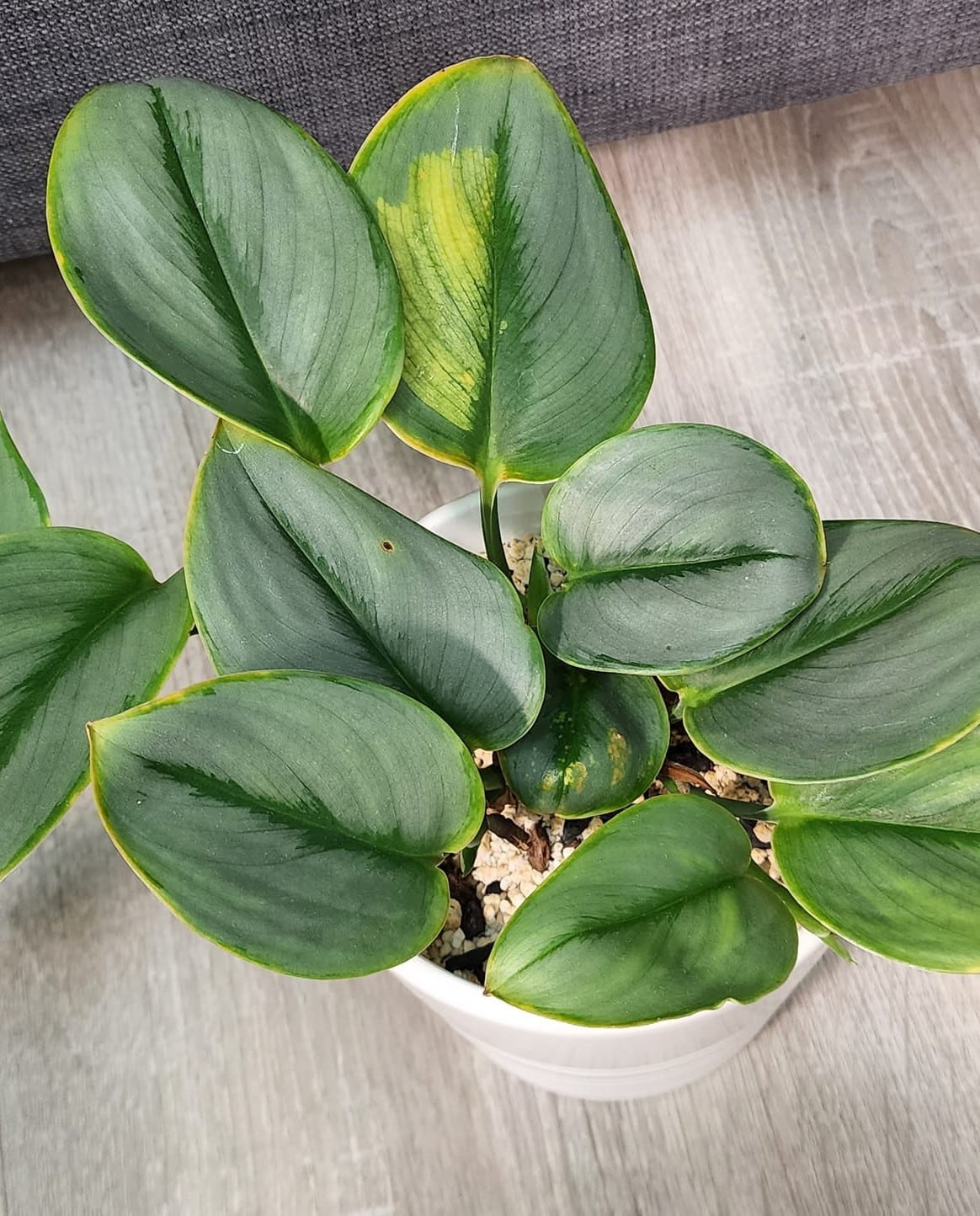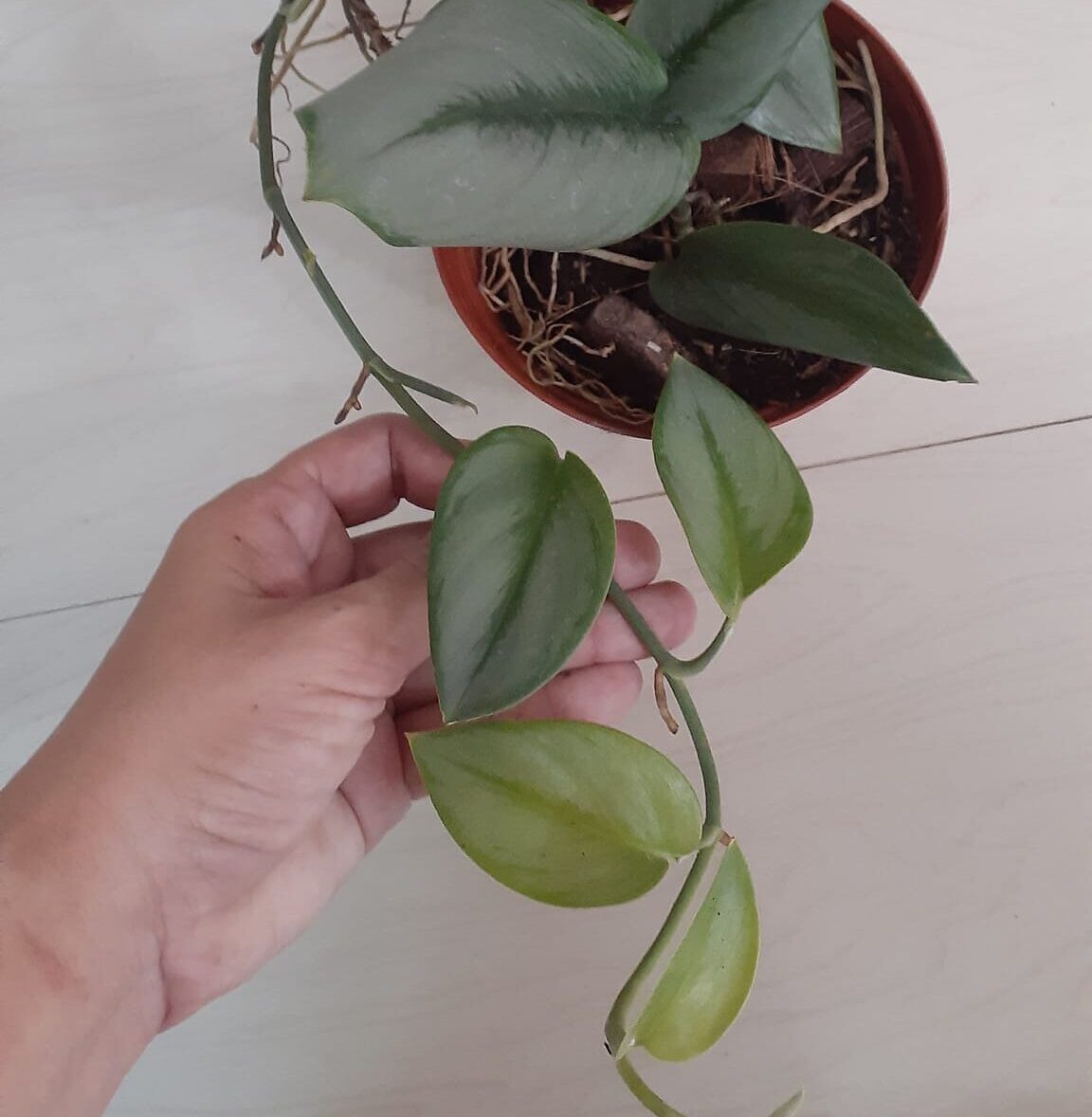Do you know the trendy Trebuii Moonlight and Pothos are entirely different plants yet look similar? But, despite their similarity, Treubii Moonlight is much more laid-back to care for!
Being an aroid plant, they are hardy and don’t need much attention, but you must watch out for pests and diseases.
Whether a beginner gardener or an expert plantsman, you can easily grow this plant if you consider the factors below.
Table of Contents Show
Treubii Moonlight Overview
Do you know the Trebuii Moonlight is nicknamed ‘Sterling Siver’ due to the silvery-gray glow on the surface of its lance-shaped leaves?
The shiny leaves are a trademark for this tropical aroid. This shine is a waxy coating on the surface of the matured leaves and is absent in some young foliage.

These leaves help reduce the transpiration rate, prevent dehydration in the warm tropical forests where it grows naturally, and keep molds away.
Want to learn more features about the plant? Check this table to get a basic overview!
| Feature(s) | Description(s) |
|---|---|
| Common Names | Treubii Moonlight Sterling Silver Sterling Silver Scindapsus Moonlight Scindapsus Dark Form Scindapsus |
| Scientific Name | Scindapsus treubii |
| Family | Araceae |
| Ecology | Life Cycle: Evergreen Perennial Habit: Herbaceous Climber Habitat: Tropical Rainforests Native Range: Malaysian Peninsula, North-Western Borneo and Java USDA Zones: 10 to 12 |
| Plant Height | 6 feet to 8 feet |
| Growth Rate | Slow |
| Growing Seasons | Spring and Summer |
| Leaf | Size: 4 inches to 20 inches long Shape: Oval to Lance-Shaped with Tapering Tips Color: Dark Green to Silvery-Gray Green Texture: Thick and Glossy |
| Flowering Season | Summer |
| Flower | Inflorescence: Spathe and Spadix Shape: Cylindrical Spadix and Leafy Spathe |
| Grown for | Shinning Silvery Leaves |
| Toxicity | Toxic to Pets and Humans |
Complete Care Guide for Treubii Moonlight
Treubii Moonlight doesn’t require much care and will do well if you mimic an appropriate indoor tropical climate for the plant.
A climbing variety, you may also need to provide it with some structural support when it overgrows skywards.

So, let’s look at some requirements for Sterling Silver!
1. Sunlight & Temperature
Trebuii Moonlight lives under the shade of humongous trees in its natural habitat.
So, it must cling to nearby plants or trees to grow up for the light source.
As a result, it is bound to get only the filtered sunlight and the resulting heat penetrating from the canopies.

Moreover, light variations significantly affect the surrounding temperature and can be problematic for the plant leaves.
Excessive Sunlight and Temperatures Issues
- Yellowing, browning, or discoloring leaves
- Crispy leaf tips and edges (sunburn)
- Dry soil and limp foliage
- Drooping and stunted growth rate
Low Sunlight and Temperature Issues
- Leaf color change (yellow to brown)
- Weak and leggy leaves
- Leaf curling and fallouts
- Slow overall growth
Tips for Proper Lighting and Temperature
- Keep the plant near an east-facing window or 3-5 feet away from a south-facing window.
- Use curtains to safeguard the plant from intense afternoon sunlight.
- Relocate the plant to a warm place away from chilly north-facing windows or cooling vents.
- Avoid dark places and instead place the plant about 6-12 inches away from grow lights for 12-14 hours when it feels light-deprived.
- Rotate the plant once a month towards the sun to allocate the light evenly for its leaves.
- Cover the plant using frost blankets in winter to prevent cold stress.
2. Watering & Humidity
The tropical habit of Scindapsus Trebuii Moonlight demands moist soil and high humidity to cheer up its foliage.
But under or overwatering and low humidity can disturb the form and health of its leaves and damage the roots.
To keep out the saturated soil conditions, keep the soil dry between watering in fall and winter.
However, most overwatering cases occur in cold months, while the plant may suffer from dehydration during spring and summer.

So, you must plant a timely, balanced watering and humidity regimen for the plant.
Overwatering Problems
- Fishy-smelling soil due to root rot
- Foliage drooping or wilting
- Yellowing, browning, and curling of leaves
Underwatering and Low Humidity Problems
- Yellow leaves due to dry soil and withered roots
- Rolled-up and limp leaves
- Crispy brown leaves and petioles
- Stunted growth and vigor due to low humidity
Tips to Manage Watering and Humidity Needs
- Place the overwatered plant in direct sunlight for a few hours to dry the soil.
- Unpot, check for rotting roots, snip the black or mushy tissues using sterilized pruners, and repot in fresh soil.
- Use a humidity tray or humidifier or group the plants to raise humidity levels.
- Amend soggy soil with some organic perlite to increase drainage.
- Dip your fingers to 1-2 inches in the topsoil to check its moisture before watering.
- Throw away stagnant water present in the pot plate after watering schedules.
- Apply the bottom-up watering method by keeping the plant in a water tray for 1o-15 minutes to hydrate the soil entirely.
3. Soil & Fertilizer
As a slow-growing plant, Treubii Moonlight is not a heavy feeder but requires fertilizer supplements during growing seasons.
Due to watering, the porous soil may lose all its minerals over time. The soil must be rejuvenated with nutrients to cope with the lost minerals.
Along with fertilizer application, the soil texture must be kept fluffy and avoid heavy or clayey soil. The roots of the plant will suffocate while watering if not done so.
As the plant remains dormant, you must halt the fertilizer application in fall and winter.

Doing so will cause the plant to undergo salt stress, a process in which the plant roots are stressed due to fertilizer salts.
Contrarily, low fertilization will also make the plant nutrient-deprived, which develops as stressful signs.
Overfertilization Problems
- Leaf fading to yellow
- Brown leaf margins and tips (fertilizer burns)
- Roots withering from tan-colored to brownish-black
- Accumulation of fertilizer salts in the topsoil and soil layers
Under-fertilization Problems
- Leaf color changes to yellow, purple, or brown shades
- Stunted roots development
- Smaller leaves and bloom number
Fertilizer Application and Soil Fortifying Tips
- To flush out the salts, strain the soil 4-5 times under distilled water.
- Remove the salt crust from the topsoil to relieve the plant from stress.
- Dilute the fertilizer to the required strength as instructed on the pack.
- Water the soil before applying fertilizer so that the moisture will evenly distribute the minerals to deeper layers.
- Place a layer of pebbles at the bottom of the pot before repotting the plant to regulate drainage.
4. Annual or Biennal Repotting
Scindapsus Treubii Moonlight is a slow-growing plant that doesn’t need repotting often.
Moreover, it prefers to stay cozy in its pot and prefers root bounding.
However, before repotting, look for root-bounding signs like stunted growth, overgrowing leaves, and roots protruding from the pot’s drainage holes.

Too frequent repotting will reduce the vigor of the roots, and the plant may go into transplant shock.
Tips for Repotting
- Water the plant heavily for 1-2 days before repotting.
- Scrape the topsoil and unpot the plant by tilting the pot to one side and applying gentle tugs.
- Free the roots from the soil clumps and break the root ball open in a bucket of water.
- Snip away all the damaged or injured root strands and groom the root ball to a small size.
- Fill a new pot one-third with potting soil over a layer of pebbles.
- Place the plant at the center and spread the roots over the soil.
- Fill more soil from the sides up to the top and keep the soil line an inch below the brim.
- Tap the soil to make it firm, make the plant stand properly, and water thoroughly.
5. Occasional Pruning
Trimming is necessary for Treubii Moonlight as it is a climber that grows to a decent size.
Their climbing growth habit lets them quickly crawl up any support and form a fuzzy appearance.
This woolly underbrush is a great hiding place for bugs and diseases that like to wreak havoc on the plant.
The best way to deal with pests and diseases is to prune the affected parts and reduce their extent.
Additionally, clearing the spent foliage and blooms is a good measure to relieve the plant from energy diversion so that it can focus on the growth of the new foliage.
Tips to Prune and Prevent Outbreaks
- Select the spent foliage, diseased leaves, and pest-infested plant parts to trim away in spring.
- Isolate the plant from the rest of the houseplants to prevent the spread.
- Using sterilized pruners, lop out the infected leaves and spent flowering stalk from their base.
- Toss or dab the bugs using strong water splashes or neem oil-soaked Q-tips to dab the pests off the leaves.
- Spray copper-based fungicides on the foliage to prevent the growth of bacterial and fungal spores.
Treubii Moonlight: All About Growth Rate and Flowering
Scindapsus Treubii Moonlight is a perennial evergreen herbaceous climber inhabiting the tropical rainforests of South-East Asia.
Treubii Moonlight is known for its leaves, making it extremely popular within the houseplant community.
A second variety of Scindapsus species, called Dark Form, has extraordinary dark-green leaves.

The plant is a slow-grower and gains an edge on its growth rate during spring and summer but begins to slow down during fall and goes completely dormant in winter.
Hence, you will see steady growth in the plant during the warmer months, when the plant grows new leaves, stems, and roots.
To support their skywards growth, you can tie their vines to a moss pole or trellis and give the plant an extra edge to spire higher.
Moreover, the leaves stay strong through most seasons, but ultimately they go yellow and drop from the plant at the end of the winter.
This allows the plant to prepare for more vigorous growth for the following season.
Although the plant rarely blooms, it overheads beautiful but unusual blooms on the flowering stalk in summer if the flowering conditions are fitting.
The blooms are called spathe and spadix, which help the plant pollinate and bear fruits.
Treubii Moonlight Toxicity
Treubii Moonlight is toxic for pets and humans due to calcium oxalate crystals in the plant parts.
Moreover, the symptoms of Moonlight plant poisoning are fatal for pets, mainly due to their body size.
Some signs of ingestion include difficulty breathing, swallowing, and tongue and lip swelling or palpitations.
But the signs become severe over time, but in humans, abrasions with the sap can cause burning and irritating rashes on the skin.
However, to save your pets and children during perils, use milk to wash away the oxalate crystals in their mouth and skin.
If your pets’ or children’s condition worsens, contact the following helpline numbers to register an emergency case.
Propagating Treubii Moonlight (Stem Cuttings)
Treubii Moonlight is best propagated by the stem or tip-cutting method.
Technically, it is the process of propagating leaf cuttings from the stem tips and rooting them in soil or water.
Additionally, the propagation can be done in spring or early summer when the plant is actively growing new nodes and leaves.
You can root the cuttings in the water and then transplant them in suitable potting soil.
1. Treubii Moonlight Propagation in Water
- Snip a 6-8 inches long healthy branch at 45° with one set of leaves and at least two growth nodes at its end.
- Plunge the cutting in a jar full of rooting hormone solution, ensuring nodes are inside the water but not the leaves.
- Place the set-up in bright indirect sunlight for 4-6 hours daily and a surrounding humidity of around 40-60%.

- Change the water every 3-5 days or when it becomes murky.
- Remember to use one jar per cutting to ensure a healthy transplant.
- After 3-4 weeks, the cuttings sprout 2-4 inches of white roots from the cut end and are suitable to transplant the soil.
- However, keep them in water for another 4 weeks for robust roots and avoid transplant shock later.
2. Treubii Moonlight Propagation in Soil
- Place a layer of pebbles at the base of the 6-inch wide terracotta planter and fill it with fresh potting mix.
- Poke a single hole at the center and plant the cutting root down.
- Cover the cuttings with plastic wrap to secure humidity (40-60%) and temperature (60-80°F).
- Again, if you use several cuttings, plant them in separate planters.
- Place the set-up in bright indirect sunlight for 4-6 hours daily and observe them for new sprouts.
- It may take 4-6 months to see any leaves, so keep them safe from pests and diseases and treat them as tropical plantlets by offering them a suitable environment.
However, there are more tips for propagating Treubii Moonlight which you can learn from the video below.
Where to Buy Treubii Moonlight?
Treubii Moonlight is a trendy houseplant that is rarely available, but there are specific commercial sites that dare to ship them.
| Sites | Expected Shipping Date |
|---|---|
| Gabriella Plants | Within 1 week after placing an order |
| Aroid Sale | Within 10-20 days after placing an order |
| Amazon | Within 4-5 days after placing an order |
| Tend Green Point | Within 1-3 days after placing an order |
FAQs About Treubii Moonlight
Is Scindapsus Treubii Moonlight and Scindapsus Treubii Moonlight Dark Form the Same?
Moonlight and Dark Form are two varieties of the same genus, Scindapsus.
Also, Dark Form bears incredibly dark-green to black leaves, while the Moonlight leaves are silvery-grayish green.
From Editorial Team
Humidity and Temperature Dictates Foliage Growth
Keep the environment sultry but let the soil stay dry between the watering to prohibit fungal root rot.
Additionally, you can fluctuate temperatures around the plant by adjusting the lighting conditions.


